What an unbelievable time it is to be an American automotive enthusiast. We have the ability to
access factory-built muscle cars that are pumping out over 600 plus horsepower with race-car capability.
As most enthusiasts know, the Mustang and Camaro have been in a long time rivalry for more than 50
years.
Since their debuts, they have been battling for the title of best muscle car. That trend
still stands firm today with the 2020 Shelby GT500 Carbon Fiber Track Package and 2020 Chevrolet Camaro
ZL1 1LE. Both the GT500 and Camaro ZL1 1LE are now the most powerful track oriented muscle cars to come out of
Detroit to date. Each is equipped with their own advanced aero, superior handling capability, and
unrivaled horsepower. It's no wonder this track battle is going to be one for the ages. Time
to figure out if either the Camaro or the Shelby has what it takes to take home the title of muscle car
king!
Rivalries Never Die
Head-To-Head
Exterior & Interior
Form & Function
Engine & Performance
Transmission
Vehicle Specs
During the 1960s, things were heating up in Motor City amongst Ford and Chevrolet. A new age of design,
engineering, and power was about to hit the market like never
before. This all started when the Mustang was unveiled at the World's Fair in New York on April 17,
1964. Starting off as what journalists called a secretaries car, Ford did not respond to these critics
lightly. Ford’s mission was to create a fun, sophisticated, and powerful sporty vehicle. Well, thanks to the help
of Carroll Shelby, Ford was able to just do this in just a few short years with the introduction of the
Fastback Mustang 289. Then in 1965, Shelby introduced the GT350 which added more power, better braking,
and superior handling that took the Mustang from mule to racehorse. While all this was occurring, Chevrolet engineers were cooking up their own pony car to enter the
market. Engineers saw how Ford became so successful with the launch of the Mustang, so they made sure
not to be left out of the segment.
A few years later, the Camaro was launched in 1967. From the
start, it was a huge hit among muscle car enthusiasts. Like the Mustang, it offered a plethora of
options
and engine choices. Designed after the classic coke bottle design, it had a broad shoulder look that was signature to
Chevrolet models. Customers took quickly to this and after just a few years of sales they knew it could
go to war with the Mustang. The only issue Chevrolet engineers had was the three years of
catching up to do since the launch of the Mustang. During that time, Carroll Shelby and Ford were way
ahead of the game with the launch of the Shelby
GT350/GT350R and GT500 with no one to stop them.
Needless to say, it was going to be an uphill battle for the Camaro and its engineers. It wasn’t long until two years later in 1969, that Chevrolet engineers would build a Camaro that was
capable of going toe-to-toe with the infamous Shelby GT500 with the 427. That year, the ZL1 Camaro was
introduced
to the public and right out the gate it caused a stir craze of excitement among muscle car enthusiasts.
With a massive 427 cubic inch big block V8 that was only intended for racing applications, Chevrolet
engineers were able to offer it through the COPO program (Central Office Production Order). This kicked
off a never ending war of titans in the world of American automotive performance! For years, Ford had been teasing enthusiasts of a new Shelby GT500 that would inject some serious venom
against the competition. This couldn’t be more true than when the all-new 2020 Shelby GT500
was unveiled
at the North American International Auto Show in January of 2019. With a monstrous 760 Horsepower and
625 LB/FT of torque. Needless to say, it put Camaro fans on alert because the king of the road was
coming
back to claim its title. Ford made it clear that they were going to benchmark the very best from the
Camaro in the ZL1 1LE. That didn’t make Chevrolet Camaro engineers run away. During this time they had been perfecting the ZL1
1LE to be the most capable track Camaro ever built. Even benchmarking themselves to make it better than
the track focused 2015 Camaro Z/28 that was already at the pinnacle of Camaro performance. Both
manufacturers knew that they had to go to extreme lengths to bring their A-game to the table in order to
have a chance to come out on top. For many enthusiasts, it came as a surprise that the new Shelby GT500 weighs over 4,000 pounds from the
factory. Many were concerned that the elephant in the room would be how the weight would cope against
its competitors. The ZL1 1LE Camaro weighs 200 pounds lighter than the GT500 due to its almost 50/50
weight distribution from front to back. But because the Shelby has the greater advantage in horsepower,
driveline, and chassis tuning, all these traits add up to the most capable handling Shelby ever built!
Where the GT500 really takes advantage is not only power, but its ability to give the driver a better
turn-in while enhancing the lateral and mechanical grip through each corner. This allows the Shelby to
power out of any corner harder and quicker due to the Dual-Clutch Transmission managing the power
efficeintly in order to not light up the
tires or create too much oversteer. On the other hand, because the ZL1 1LE has an almost perfect weight
distribution from front to rear, it allows for a better corner entry as the GT500 has a better corner
exit due to the extra horsepower allowing it to pull out harder and quicker than the Camaro. Styling and design has been the signature trademark for every Shelby and Camaro to date. This is no
different for the new GT500 or Camaro ZL1 1LE. At first sight you can tell that both Ford and Chevrolet
were out to make the most aggressive versions of these two monsters to date. Looking at the Camaro from the front, it displays a commanding wide stance that is very intimidating with
a front fascia that demands attention. The massive grille looks like it is going to suck you in no
matter what you do. With a more aggressive front splitter than the standard ZL1, including the added
dive planes says nothing but race car. Bulging out of the hood is a massive carbon fiber heat extractor
to help reduce engine bay temps. Moving around the ZL1 1LE, its aggressive design language continues
through the body lines and curves that move to the wide rear quarters that allow for the massive
325/30/ZR19 size rear tires. In Camaro history, it has to be one of the meanest and most aggressive
designs to date. As most Shelby GT500 models go, they are designed to put fear and intimidation into the competition. This
design language continues with the 2020 GT500 with added traits that resemble a real Cobra. From head on
you can see that the front fascia has a design that resembles a fang like appearance front and center.
The largest grille openings ever in a production Shelby help cool down 760 horsepower, while still
retaining classic Shelby design elements. Like all previous GT500 models, the Cobra emblem is front and
center to help command road presence. For 2020, Ford put the largest Cobra emblem on the GT500 ever to
make a
statement. Like the ZL1 1LE, it has a much wider front track to allow for larger wheels and tires. But
also giving it classic muscle characteristics without going too over the top. Moving to the side of the Shelby, you will notice a fender Cobra badges, side skirt splitters, a fastback
profile, and signature quarter haunches that have always made the Mustang and Shelby legendary. At the
rear of the GT500 and Camaro ZL1 1LE, each have large carbon fiber rear spoiler, quad tip exhaust,
and massive rear diffusers to aid in creating the most efficient aerodynamics possible. Looking
at either of these American track beasts, one thing is clear to us: they both mean business! On the inside of the ZL1 1LE and GT500, interior have a lot of similar traits to one another. Each
has a race inspired design that is focused towards the driver. This is all without sacrificing a
comfortable
and sporty cabin. Both boast Recaro race-inspired seats that hold you in place while carving up your
favorite track or canyon road. Each seat is equipped with leather and alcantara inserts that not only
look great but provide functionality. You can tell that a lot of the materials are the same from the trickle down effect in both the Mustang
and Camaro lineup. But each model has unique door panels, steering wheels, carbon fiber accents
, and soft touch materials such as leather and alcantara on the steering wheel. Each comes equipped with
a center stacked infotainment screen equipped with either the latest in
Ford Sync or Chevrolet MyLink. Other technology includes a 12-inch digital display on the Shelby GT500 dashboard that boasts a
completely
customizable display that allows you to have all necessary information right in front of the driver such
as boost pressure, air/fuel ratio, and transmission temperature. The Camaro has an analog gauge cluster
combined with a smaller digital display that features multiple customizable gauges as well. Contrary to popular belief, some of the materials in the Camaro feel cheaper compared to the GT500
such as the paddle shifters, center console plastics, and dashboard. Whereas the Shelby seems to have
higher quality materials such as a carbon fiber dash panel and softer leather. Where the Camaro
falls short is the choice of receiving a rear seat delete, Recaro seats allow a pass through design to
allow for shoulder harnesses for the track, and room to add in a bolt-in roll cages. These two track monsters are the pinnacle in American automotive performance. Each of them bench way
above their weight class in terms of handling, precision, and functionality. While both the Camaro and
Mustang are amazing in their base V8 forms, nothing can compare to the all out track versions that the
Shelby GT500 Carbon Fiber Track Package and Camaro ZL1 1LE offer. The GT500 Carbon Fiber Track Package takes this snake from lethal to deadly. By adding 20 inch
exposed carbon fiber wheels, the Shelby saves up to 20 pounds of rotational mass. It also comes with an
exposed carbon fiber GT4 Mustang spoiler, oil separator, rear seat delete, Michelin Pilot Sport Cup 2
tires, Recaro sport bucket seats, rear seat delete, splitter wickers, exposed carbon fiber dash panel,
and adjustable top strut mounts. All of these combined take the already potent GT500 into race car
territory while still being street legal. These aerodynamic properties help the Shelby corner harder into every apex and stick like glue to the
road. If you think that Camaro isn’t going to be able to keep up with the Shelby, you are mistaken. The
1LE package on the ZL1 adds a host of upgrades to enhance the Camaros already potent capability. By
adding extreme aerodynamics just like the Shelby, the ZL1 1LE turns the ZL1 into an absolute track
beast.
Chevrolet equips the 1LE with a host of upgrades including 19 inch forged one piece aluminum wheels,
exposed carbon fiber rear wing, dual mode exhaust, dive planes, larger front splitter, revised
suspension tuning, Multimatic DSV front adjustable dampers, and additional 300 pounds of downforce. All
of these add up to be an experience that only the 2020 GT500 can match. Along with all this amazing aero and cornering capability, is the braking power that both are equipped in
order to slow down all that horsepower. On the GT500 comes the largest front rotors of any modern
American sports coupe available: 16.5 inch rotors with 6-piston Brembo calipers along with 4-piston
rear calipers with 15” rotors. While the Camaro receives a similar treatment in calipers equipped with
6-piston front and 4-piston Brembo brakes as well. Like all Shelby GT500 models of the past, the approach to all-out engine performance has been a no
compromise attitude to create the most venom possible. The same goes for the “Predator” 5.2L cross-plane
crank V8. Like its little brother the Shelby GT350/GT350R, it shares a lot of the engine components
found in the 5.2L “Voodoo” engine, except the crankshaft which is a cross-plane crank not a flat-plane
crank. The reason is due to the compression the Predator engine has to run in order to handle the
massive 2.65L Eaton supercharger and all the boost pressure being forced into the engine. The Predator creates a staggering 760 horsepower at 7,300 RPM to the flywheel effortlessly. Engineered
with the best internal engine components in a Ford V8 to date. It rivals the 2005-2006 Ford GT 5.4L and
2013-2014 “Trinity” 5.8L GT500 engine. Ford knew that in order to create the most powerful production
Shelby ever built, they would have to go to every length to build a race car-like engine. Like the basis
of all “Coyote” engines, each come standard with Ti-VCT (Twin Independent Variable Camshaft Timing)
which
allows for efficient combustion, creating maximum power per liter, and freely moves the intake valves to
move independently from one another. Each Predator GT500 engine is built by hand at the Ford Romeo-Niche plant in Detroit. Each one is
hand-built
signed by the engine builder, just as all previous GT500 have been in the past. As the Predator engine is being assembled it is built with components such as: Like the Predator engine, the LT4 is supercharged. The LT4 6.2L V8 is also equipped with an 1.7L Eaton
R1740
TVS supercharger and shares the same TI-VCT (Twin Independent Variable Camshaft Timing) technology.
Allowing for a more efficient combustion while still allowing the engine to create huge amounts of power
throughout the RPM range. This is where the similarities stop. As most Chevrolet V8 engines go, they are
all derived from the original small-block V8 platform that was introduced in the late 1950s. But don’t
let that fool you, this LT4 is an absolute monster that needs to be taken seriously. Just like its big
brother, the Corvette Z06 shares the same incredible 650 horsepower at 6,400 RPM and 650 lb/ft of
torque at 3,600 RPM. This allows for instant power as soon as you smash the throttle in any gear. There is no doubt that the LT4 has more low-end torque which helps it get out of the gate better.
However, it
still can’t make up the extra 110 horsepower to keep up with the GT500 on the back straights at the
track. The camshaft is mounted in the center of the engine block and an inverted supercharger which
allows the LT4 to provide a better weight distribution in the front vs the GT500. This allowed Chevrolet
engineers to mount the LT4 lower down and further back in the ZL1 1LE for a mid-engine like experience
that rivals supercar territory for half the cost. For the first time ever, the GT500 would not receive a manual transmission. For some purists, this was
quite upsetting because of the direct and engaging feel that only a manual can provide. Ford engineers
were concerned about making the new GT500 with the most capable powertrain ever. Along with putting all
760 horsepower to the ground efficiently. What the 7-Speed Tremec TR-9070 Dual Clutch Transmission offers is the ability to drive like an
automatic, but still have the feeling of being a manual transmission without having a clutch pedal at
your feet. By allowing the transmission to be completely ready for the next gear even before engaging
it, you
are able to shift in less than 80 milliseconds. Think about that for a minute. You are shifting faster than you can blink! No manual transmission would
be
able to do this. This transmission allows for the most efficient power transfer throughout the driveline
ever in a GT500. Putting all of the power to ground in the most efficient way. This gives the leg up
over the Camaro from a corner exit ability to put down the power out earlier while exiting a sweeping
corner. Unlike the GT500, the ZL1 1LE has the option to choose from either a 10-speed automatic co-developed with
Ford or a Tremec six-speed manual transmission. When the ZL1 1LE was first launched, it was only offered
with the manual but Chevrolet engineers realized that it could be much quicker with the option of the
10-speed auto. The manual comes equipped standard with a 3.73 final drive ratio and auto match rev
matching. To enable the driver to have perfect downshifts during spirited driving situations. Both transmission options give the ZL1 1LE a race-inspired feel without sacrificing on-road drivability.
While the automatic makes the Camaro faster around the track, nothing can be said for the direct feel
and
engagement a
manual transmission gives to the driver. 2021 Mustang Mach 1 vs Shelby GT350 Mustang GT California Special History Shelby GT500 vs Shelby GT350R Compared Source: Ford, Chevrolet, Car & Driver, AutoTraderAmerican Rivalry: 2020 Shelby GT500 vs Camaro ZL1 1LE
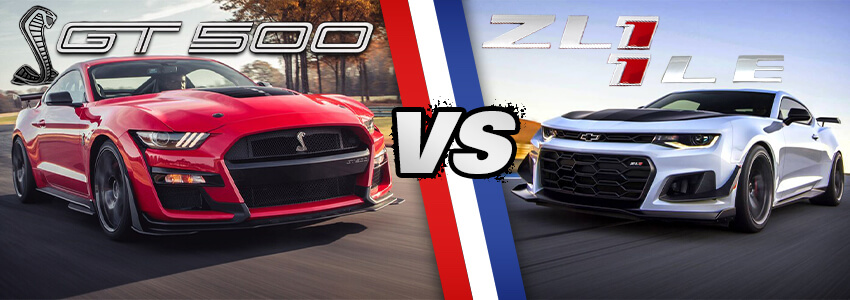

Rivalries Never Die
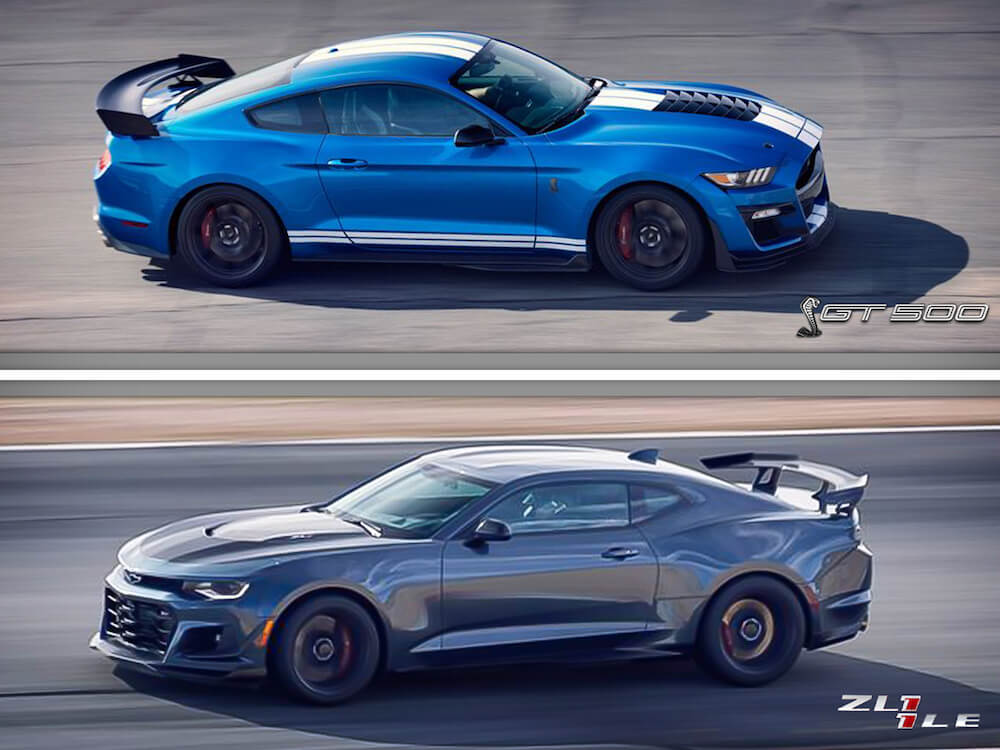
Head-To-Head
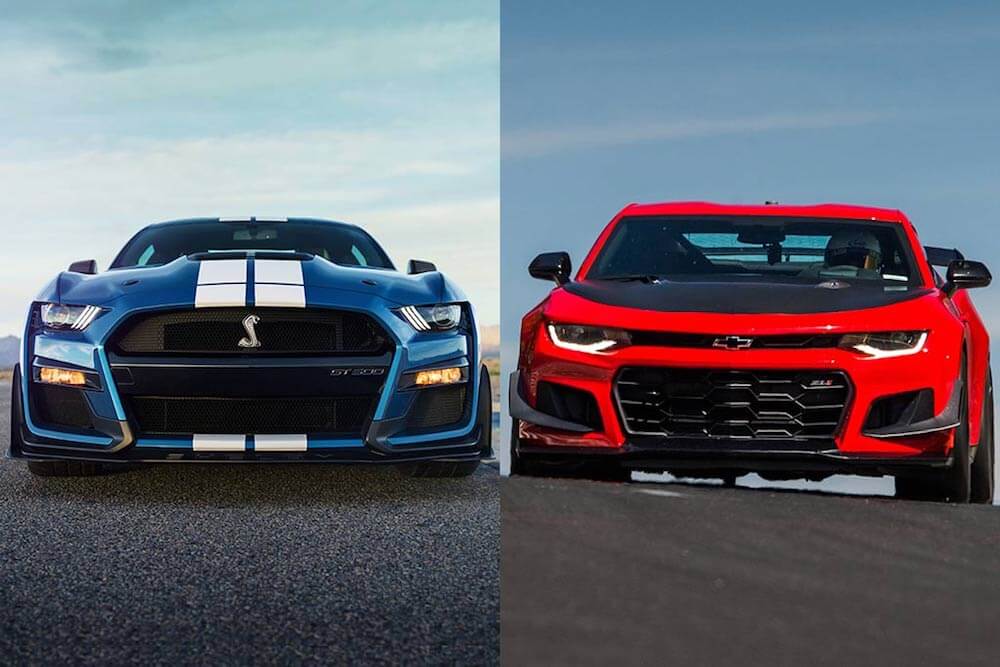
GT500 vs ZL1 1LE: Exterior & Interior
GT500 vs ZL1 1LE: Exterior
GT500 vs ZL1 1LE: Interior

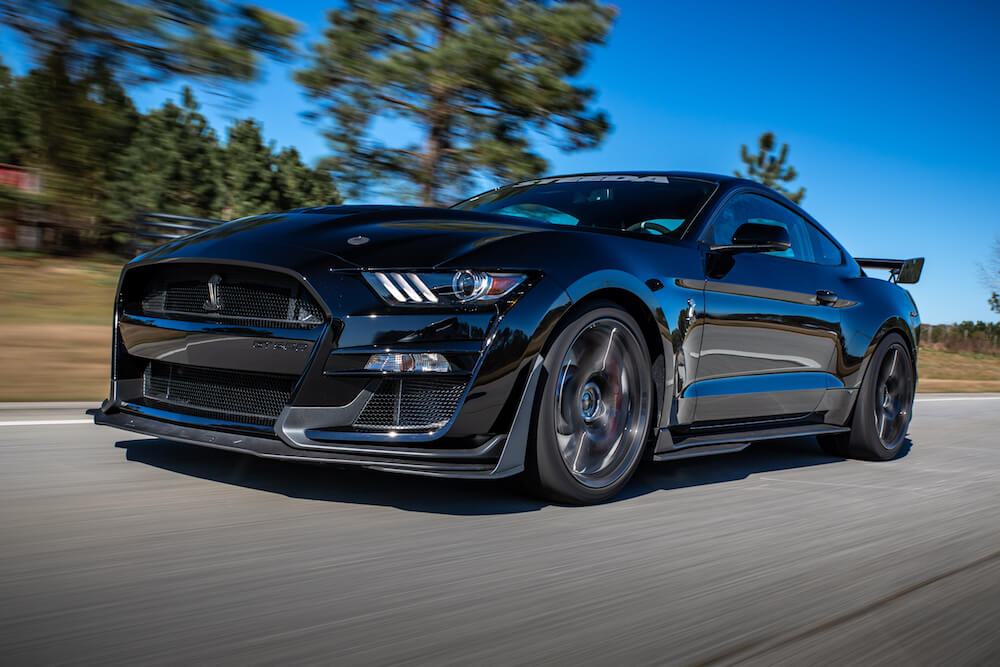
GT500 vs ZL1 1LE: Form & Function
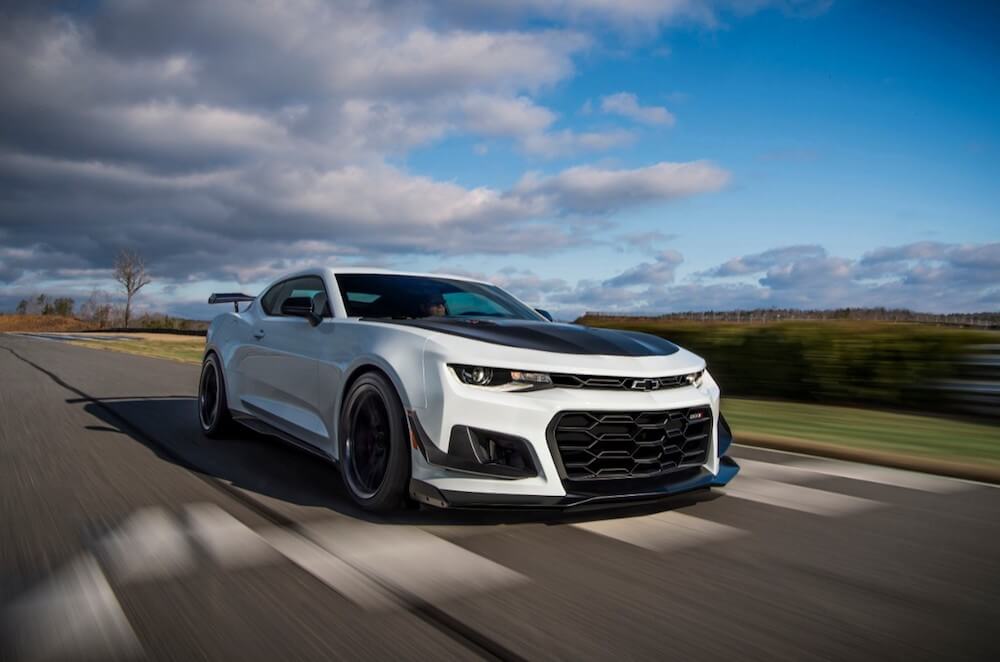
GT500 vs ZL1 1LE: Engine & Performance
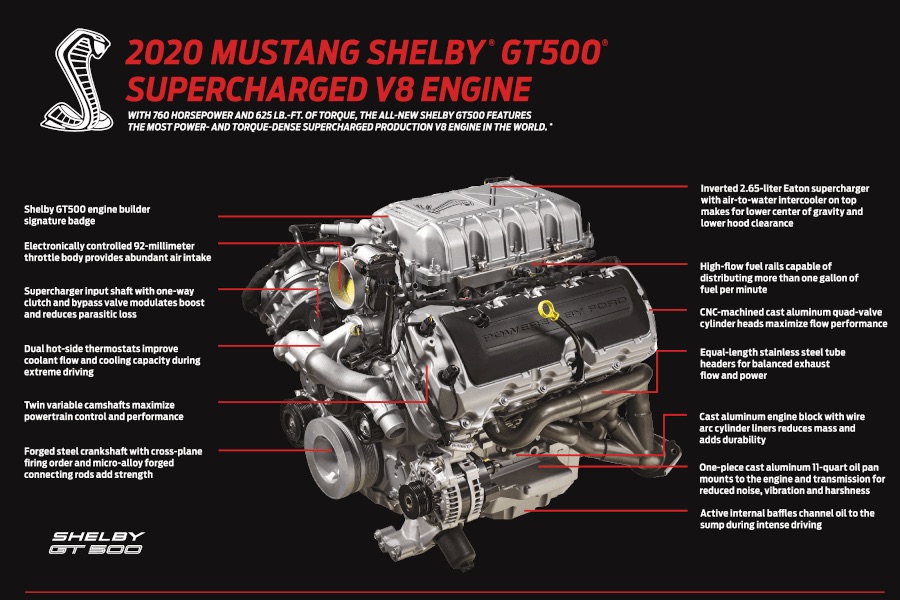
2020 Shelby GT500: 5.2L Predator
2020 Camaro ZL1 1LE: 6.2L LT4 Engine
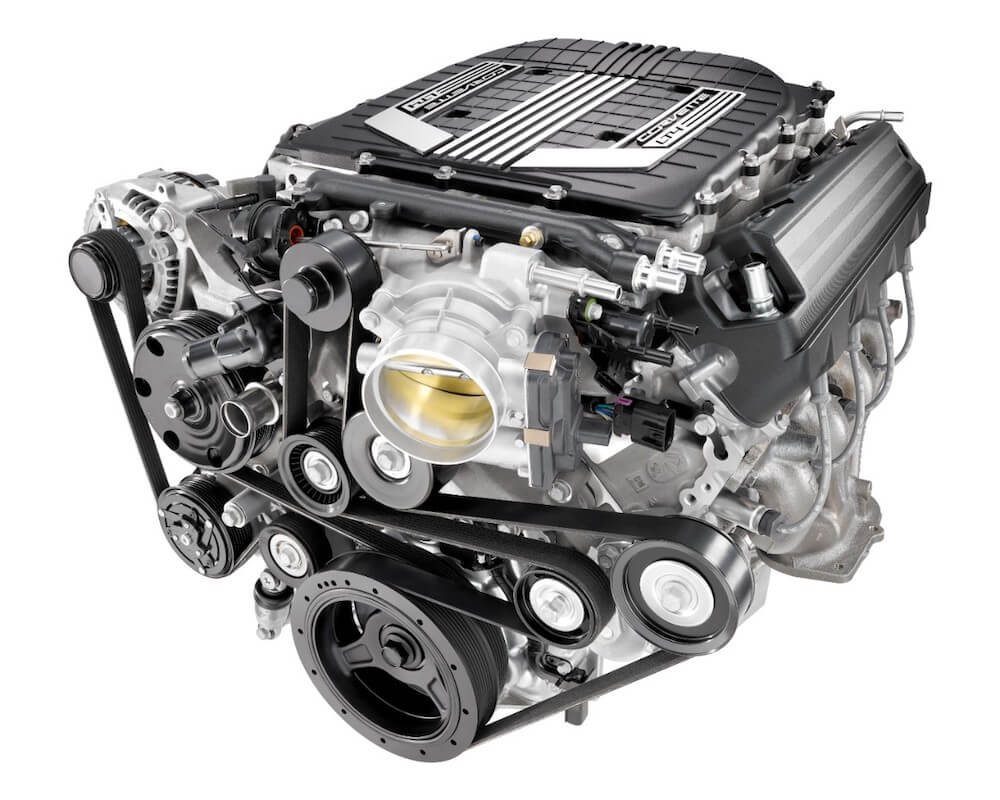
GT500 vs ZL1 1LE: Transmission
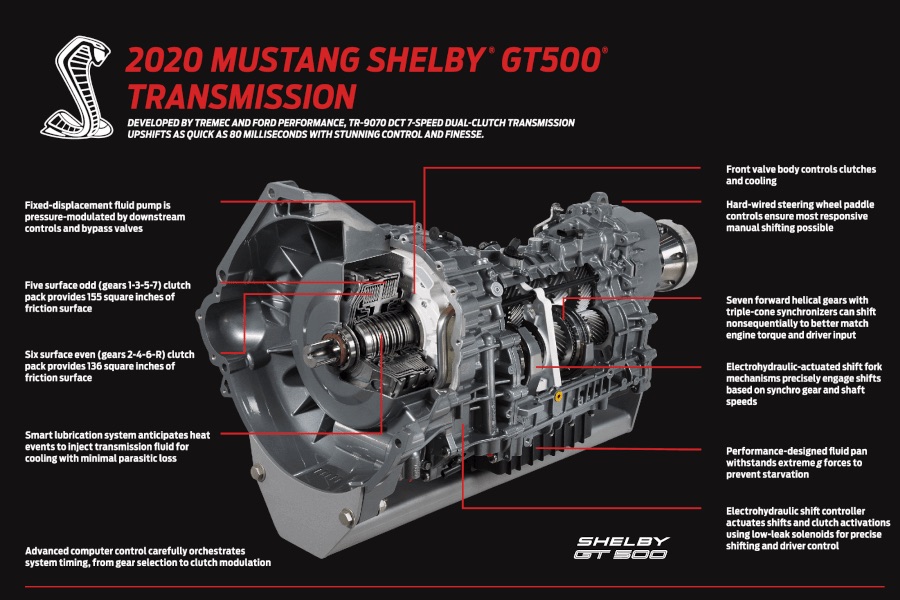
GT500: Tremec TR-9070 DCT
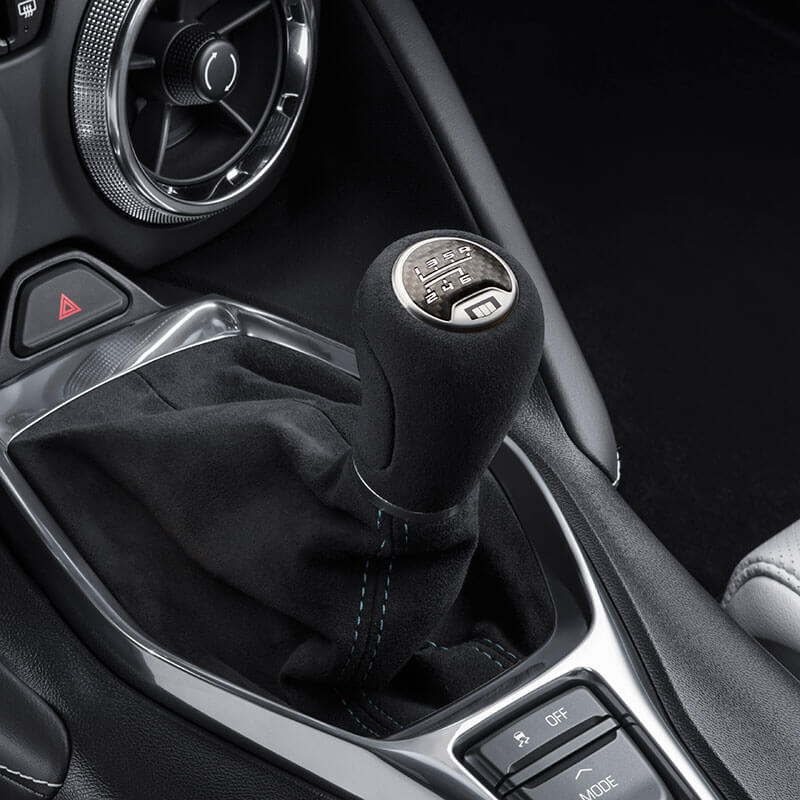
ZL1 1LE: 10-Speed Auto or 6-Speed Manual
GT500 vs ZL1 1LE: Vehicle Specs
Vehicle Specs
2020 Ford Shelby GT500
2020 Chevrolet Camaro ZL1 1LE
Base Price
$73,995
($93,780 w/Carbon Fiber Track Package)
$72,195 (1LE $75,985)
Drivetrain Layout
Front Engine, RWD
Front Engine, RWD
Engine
“Predator” Supercharged Cross-Plane Crank, 90-degree V-8, Aluminum Block & Cylinder Heads
LT4 Supercharged Aluminum Block & Cylinder Heads V-8
Valvetrain
32V DOHC TI-VCT
16 Valve Pushrod Single Cam TI-VCT
Displacement
5.2L, 315 Cubic Inches
6.2L, 376 Cubic Inches
Compression Ratio
9.5:1
10:1
Horsepower
760
650
Torque
625 LB/FT
650 LB/FT
Redline
7,500 RPM
6,400 RPM
Power To Weight Ratio
5.3 LB/HP
5.9 LB/HP
Transmission
Tremec TR-9070 DCT, 7-Speed Dual-Clutch Transmission
10-Speed Automatic or 6-Speed Manual
Rear Axle Ratio
Torsen 3.73
3.73 (Manual)
2.85 (Automatic)
Front Suspention Configuration
Struts, coil springs, adj shocks, anti-roll bar
Multimatic DSSV® (Dynamic Suspension Spool Valve) dampers; adjustable camber plates
Rear Suspension Configuration
Multilink, coil springs, adj shocks, anti-roll bar
Independent Rear Suspension
Brakes Front & Rear
Brembo 16.5-in 2-pc vented disc / 14.6-in 2-pc vented disc, ABS
Brembo 6-Piston Front, 4-Piston Rear
Wheels
20” x 11” / 20” x 11.5”, carbon fiber composite
Front: 19-in. x 11-in. forged aluminum
Rear: 19-in. x 12-in. forged aluminum
Tires
305/30R20 103Y / 315/30R20 104Y, Michelin Pilot Sport Cup 2
305/30R19 | 325/30R19 Goodyear Eagle F1 Supercar 3R
Related Articles





